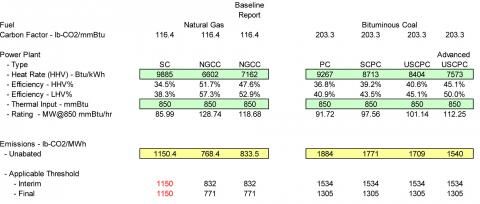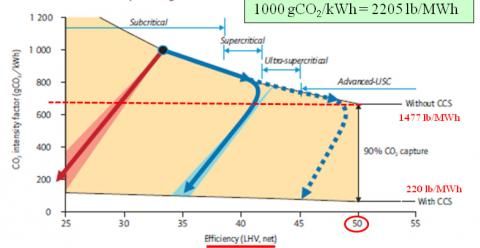CO2 from gas turbines is the same as CO2 from coal plants
Under the new Clean Power Plan, the EPA calculates state goals based on the Best System of Emission Reduction (BSER), and has now established separate emissions performance rates for coal and natural gas plants, as follows:
- An interim emissions rate for existing coal units of 1,534 lbs CO2 per Net MWh, and a final rate of 1,305 lbs-CO2 per Net MWh
- An interim emissions rate for existing natural gas units of 832 lbs CO2 per Net MWh and the final rate of 771 lbs-CO2 per Net MWh
The following table has been modified from the original 2014 version to calculate the Advanced-USCPC CO
2
emissions based on a 50% LHV value with the 203.3 lb-CO
2
/mmBtu carbon factor. The NGCC values are shown, as before.

The Natural Gas Combined Cycle (NGCC) power plant meets the 832 lb-CO
2
/MWh interim level now, and the final 771 level without any form of CO
2
abatement, if expected efficiency gains are realized.
The graphic shown below was developed as part of an International Energy Agency “Road Mapping” exercise toward a High-Efficiency, Low-Emissions (HELE) coal fired power plant, shown as an Advanced Ultra-Supercritical Pulverized Coal (Advanced-USCPC).
The graphic indicates that at 50% LHV efficiency, the CO
2
emissions would be ~1477 lb-CO
2
/MWh (~670 gCO
2
/kWh).

The Advanced Ultra Supercritical Pulverized Coal Plant(USCPC) at 1540 lb-CO2/MWh, would appear to meet the interim full load threshold level of 1534 lb-CO
2
/MWh, but another 15% efficiency improvement would be required to meet the final threshold of 1305 lb-CO
2
/MWh. Either that, or 15% Carbon Capture would be required.
In the most optimistic scenario, these new thresholds would position a NGCC without abatement against the Advanced-USCPC, also without abatement.
There are no first cost estimates for the Advanced-USCPC, but its lower efficiency predecessor was at least 3x the first cost. The efficiency, defined above, favors the NGCC. It should be noted that this comparison assumes significant efficiency improvement in both the NGCC and the Advanced-USCPC. Industry experience to date suggests that gas turbine concepts are much more likely to realize these efficiency improvements than coal-based efforts, and to reach them sooner.
The fuel cost differences are also narrowing, as shown in the following data extracted from the Energy Information Agency’s August 2015 year-over-year comparison, reducing coal’s historical price per mmBtu advantage.

At a nominal 550MW, the annual fuel cost difference is $23 million per year, in favor of the Advanced-USC, requiring a 40-year simple payback on the ̴$1.0 billion first cost difference.
If the differences in CO
2
emissions were added at $60/Mt, the combined fuel and CO
2
operating costs would shift in favor of the NGCC at $30 million per year.
The breakeven point would be about $25/Mt of CO
2
at the fuel and efficiency rates.
A couple of things are happening here:
1. This dual standard concession is the result of the successful coal industry challenge on whether CCS was a “commercially available” technology. The EPA is prohibited from mandating a technology that is not “commercially available”.
2. The EPA is pandering to the coal industry by giving them their own standard and more importantly, the opening to dismiss CCS as a laboratory-level R&D level technology in hopes of building coal plants without CO
2
abatement.
3. Natural Gas Combined Cycle Power Plants will continue to be built without doing anything about CO
2
emissions. This has been the EPA’s primary objective throughout and that objective remains intact. This is Business as Usual dressed up to look like climate action.
4. In so doing, this EPA has, once again, chosen not to support CCS technology development, acknowledged to be part of any 2°C/450 ppm target.
5. CCS has been “kicked down the road” until 2030, at a minimum, when we “finally” realize that deploying CCS on NGCC plants is required to reach at 2°C/450 ppm level. We know that now! We are just wasting 15-years that we will wish we had. Mother Nature does not allow “do-overs”.
6. This is a recognition that we are on 4°C/720-1000 ppm trajectory, and that seems to be OK!
7. ……Really?
It should be noted that CO2 that comes from a coal plant is the same as the CO
2
that comes from a gas plant. The original standard was correct in that the threshold(s) was independent of source.
In the end, it is just CO
2
!
(Pete can be reached at pete_baldwin@base-e.net)